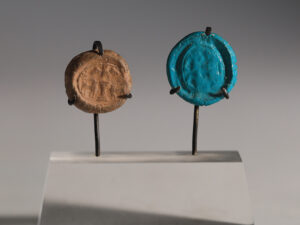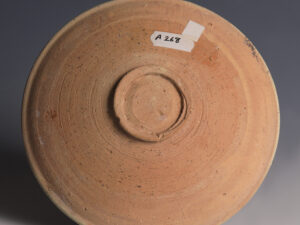African Red Slipware is identified as the final development of terra sigillata, from the Latin, meaning ‘sealed earth’. Terra sigillata was a form of Roman red slipware pottery, which was developed around the mid-1st century BC, both for domestic use and export. These pieces were modelled on the lathe directly in the matrix, on which decorative motifs were hollowed out and then impressed on the smooth body of the vessel, appearing therefore in relief. Sometimes the decorative motifs in relief would have been applied to the vessel by using very thin, liquid clay. One of the most important centres of production was the Italian city of Arretium (modern day Arezzo). However, terra sigillata wares were produced also in Gaul and later in North Africa and Asia Minor, where the Italian prototypes were initially imitated, then evolved into new shapes, creating unique and distinctive styles. Terra sigillata vessels were often decorated in accordance with traditional Greco-Roman tastes, presenting images of classical mythology, hunting scenes and divine figures.
 Ancient Egyptian Faience Mummy Mask
$577.01
Ancient Egyptian Faience Mummy Mask
$577.01
 Egyptian Clay Papyrus Impression with a Stylistic Design
$101.83
Egyptian Clay Papyrus Impression with a Stylistic Design
$101.83
Roman North African Red Slipware Plaque with Lioness and Hunter
$672.05
A fragment of an Ancient Roman North African red slipware plaque depicting a lioness and a hunter. The relief, executed in the typical classical style, shows the side profile of a lioness facing right with both its forelegs and hind legs outstretched in a leaping position. The anatomical features of the animal have been naturalistically rendered, including the paws, long tail and facial features. In front of the lioness is a human, also facing right, running with a large hunting spear in both arms projecting forward. The reverse of the piece remains unworked.
1 in stock
Additional information
| Weight | 273.5 g |
|---|---|
| Dimensions | 21.6 × 7.2 cm |
| Culture | Ancient Roman |
| Pottery porcelain | Redware |
| Region | North Africa |
















